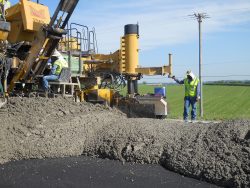Geotextiles
 Geotextile fabrics have been used by pavement engineers for many years as a separation layer between full-depth concrete pavements and stiff cement-treated bases. Because of that success, pavement engineers have recently been evaluating nonwoven geotextiles as an alternative to hot-mix asphalt (HMA) separation layers in unbonded concrete overlay applications.
Geotextile fabrics have been used by pavement engineers for many years as a separation layer between full-depth concrete pavements and stiff cement-treated bases. Because of that success, pavement engineers have recently been evaluating nonwoven geotextiles as an alternative to hot-mix asphalt (HMA) separation layers in unbonded concrete overlay applications.
After nearly 10 years of positive project performance, it was found that nonwoven geotextile fabric separation layers work very well when used on existing pavements that have received the appropriate level of pre-overlay repairs. The fabric acts as a separation material to prevent cracks and other distresses in the underlying pavement from compromising the performance of new unbonded jointed concrete overlays placed over existing jointed and continuously reinforced concrete pavements. The fabric has also been shown to provide sufficient drainage to unbonded concrete overlay systems.
It was also found that the use of geosynthetic fabrics as a separation layer can provide significant cost and time savings when compared to traditional asphalt separation layers. State highway agencies are engaged in continuing research efforts to optimize the use of geotextile fabric separation layers.
Following are some of the resources developed by the National CP Tech Center and its partners on geotextiles.
